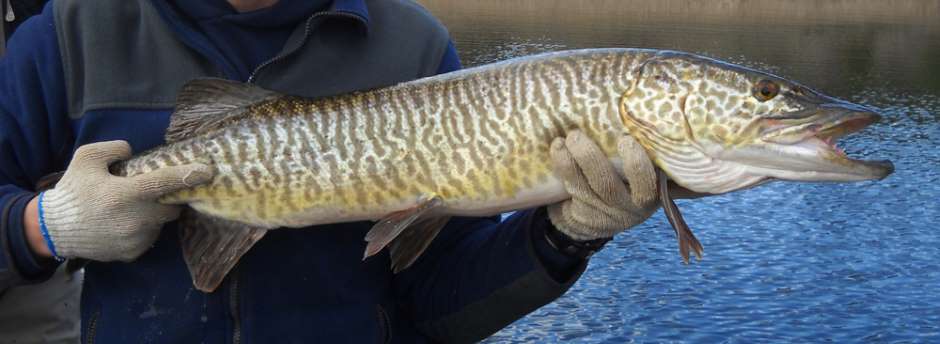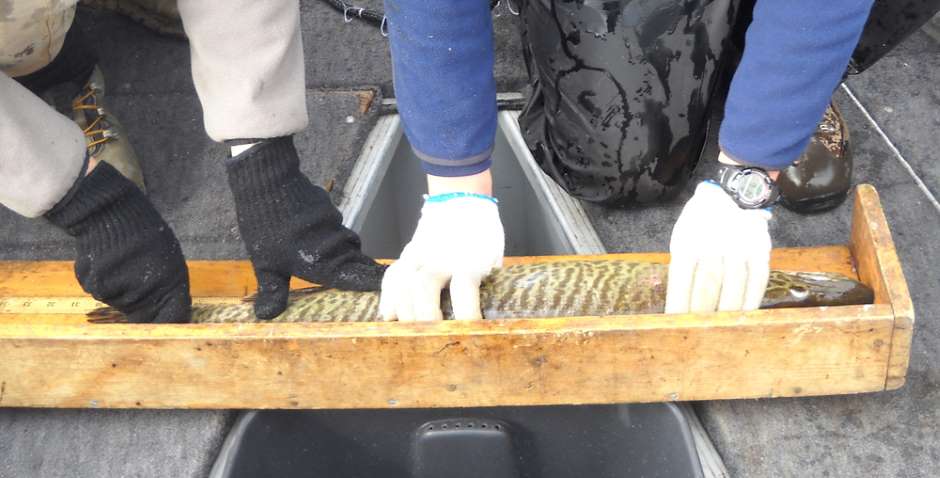Study: Impacts of Tiger Muskie on Stocked Salmonid Populations
 A tiger muskie stocked in a Colorado reservoir (Credit: Jesse Lepak/Colorado Parks and Wildlife)
A tiger muskie stocked in a Colorado reservoir (Credit: Jesse Lepak/Colorado Parks and Wildlife)Tiger muskies are popular with anglers as a highly sought-after trophy fish and have been thought to serve as protectors to hatchery fish. Hatcheries invest a great deal of time and resources into raising fish for stocking in local waterways, and predators in hatchery waters can serve as a threat to all of that work.
Hatcheries have dealt with these predators through a variety of strategies, but some have proposed enlisting the help of larger predator species that can protect the smaller fry. Some have proposed that tiger muskies might help control predators or competing populations for hatchery fish—protecting the juvenile fish from native predators and removing competitors from the ecosystems.
A study published by Lake and Reservoir Management in 2014 examines how the use of tiger muskies—a sterile cross between true muskellunge and northern pike—can control the population of predators like white suckers who threaten stocked salmonids.
Of course, tiger muskies are still predators regardless, and the use of these fish was also hypothesized to have the opposite effect, meaning that the stocked tigers end up eating the salmonids instead of the suckers.
Stocking Predators and Prey in Colorado
Therefore, the tricky part is determining if the tiger muskies pose a threat to the stocked salmonids or if the fish serve as a guardian of sorts. The stocked fish are pricey investments, and while tiger muskies are popular with anglers, they may pose a threat to the stocked salmonids.
The state has historically stocked tiger muskies to control naturally reproducing white sucker populations since the suckers compete with hatchery-raised rainbow trout and other salmonids. Prior to the study in 2014, there was no solid evidence that the simultaneously stocked muskies were consuming the hatchery-reared salmonids.
“We’re stocking tiger muskies in lakes where there are a lot of white suckers that we would like to control,” stated Jesse Lepak, an aquatic research scientist with Colorado Parks and Wildlife. “But if there is other forage available, will they consume those or will they eat the white suckers as we intended them to do?”

Measuring a tiger muskie from a Colorado reservoir (Credit: Jesse Lepak/Colorado Parks and Wildlife)
Five reservoirs were chosen to be investigated: Big Creek, Clear Creek, De Weese, Parvin and Pinewood. Each site had naturally reproducing populations of white suckers and stocked salmonids like rainbow and cutthroat trout and kokanee salmon.
Muscle tissues were sampled from tiger muskies, suckers and trout from the five reservoirs. Chemical tracers were used to see what proportion of the muskie’s diet was made up of suckers and hatchery-raised fish.
The species can be easily distinguished in the tiger muskies as the suckers carry a chemical signature associated with the freshwater lakes in which they’re born and raised, while the stocked salmonids leave a chemical signature associated with marine systems — a holdover from their days in the hatchery eating pellets made up of ocean species.
Results
The results of the study indicate that the muskies were eating more stocked salmonids than white suckers in every reservoir. “It wasn’t 100 percent hatchery forage or anything like that, but there were cases where it was a higher proportion of hatchery fish than others,” Lepak said.
The lesson dealt a blow to the state’s current stocking efforts but provided valuable information on how to improve the state’s stocking program. Tiger muskies are still valuable fish, and the findings of the study simply redirect stocking efforts to other waterways where the stocked salmonids and muskies can thrive separately from one another.



0 comments